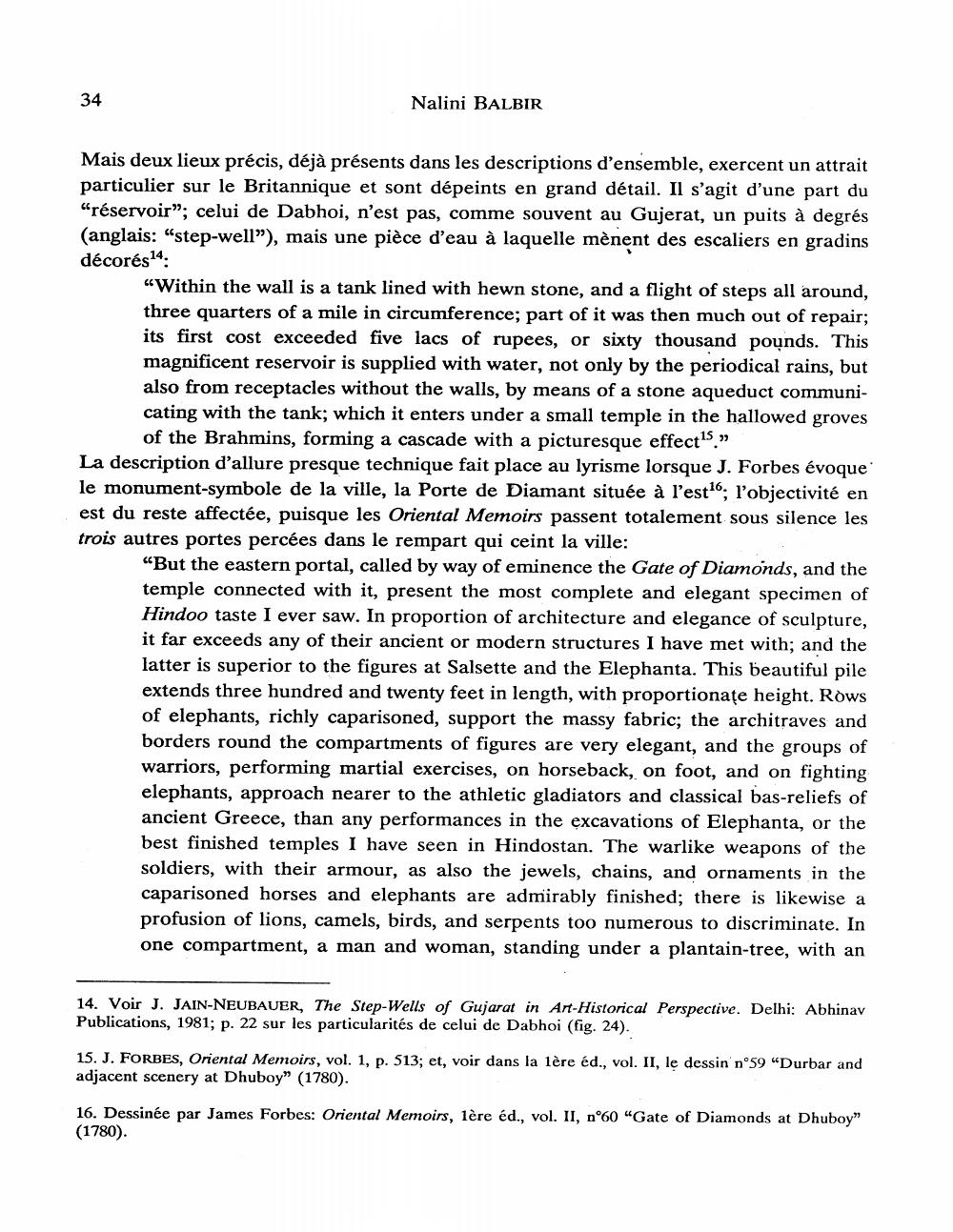Book Title: Rencontres Indo Britanniques Au Gujerat A Propos Dune Nouvelle De Dhumketu Author(s): Nalini Balbir Publisher: Nalini Balbir View full book textPage 4
________________ 34 Nalini BALBIR Mais deux lieux précis, déjà présents dans les descriptions d'ensemble, exercent un attrait particulier sur le Britannique et sont dépeints en grand détail. Il s'agit d'une part du "réservoir"; celui de Dabhoi, n'est pas, comme souvent au Gujerat, un puits à degrés (anglais: “step-well”), mais une pièce d'eau à laquelle mènent des escaliers en gradins décorés 14: “Within the wall is a tank lined with hewn stone, and a flight of steps all around, three quarters of a mile in circumference; part of it was then much out of repair; its first cost exceeded five lacs of rupees, or sixty thousand pounds. This magnificent reservoir is supplied with water, not only by the periodical rains, but also from receptacles without the walls, by means of a stone aqueduct communicating with the tank; which it enters under a small temple in the hallowed groves of the Brahmins, forming a cascade with a picturesque effect".” La description d'allure presque technique fait place au lyrisme lorsque J. Forbes évoque le monument-symbole de la ville, la Porte de Diamant située à l'est16; l'objectivité en est du reste affectée, puisque les Oriental Memoirs passent totalement sous silence les trois autres portes percées dans le rempart qui ceint la ville: “But the eastern portal, called by way of eminence the Gate of Diamonds, and the temple connected with it, present the most complete and elegant specimen of Hindoo taste I ever saw. In proportion of architecture and elegance of sculpture, it far exceeds any of their ancient or modern structures I have met with; and the latter is superior to the figures at Salsette and the Elephanta. This beautiful pile extends three hundred and twenty feet in length, with proportionate height. Rows of elephants, richly caparisoned, support the massy fabric; the architraves and borders round the compartments of figures are very elegant, and the groups of warriors, performing martial exercises, on horseback, on foot, and on fighting elephants, approach nearer to the athletic gladiators and classical bas-reliefs of ancient Greece, than any performances in the excavations of Elephanta, or the best finished temples I have seen in Hindostan. The warlike weapons of the soldiers, with their armour, as also the jewels, chains, and ornaments in the caparisoned horses and elephants are admirably finished; there is likewise a profusion of lions, camels, birds, and serpents too numerous to discriminate. In one compartment, a man and woman, standing under a plantain-tree, with an 14. Voir J. JAIN-NEUBAUER, The Step-Wells of Gujarat in Art-Historical Perspective. Delhi: Abhinav Publications, 1981; p. 22 sur les particularités de celui de Dabhoi (fig. 24). 15. J. FORBES, Oriental Memoirs, vol. 1, p. 513; et, voir dans la lère éd., vol. II, le dessin n°59 "Durbar and adjacent scenery at Dhuboy” (1780). 16. Dessinée par James Forbes: Oriental Memoirs, lère éd., vol. II, n°60 "Gate of Diamonds at Dhuboy" (1780).Page Navigation
1 2 3 4 5 6 7 8 9 10 11 12 13 14 15 16 17 18 19 20 21
